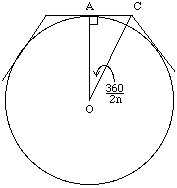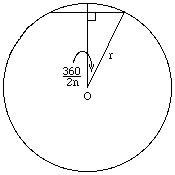

Date: Tue, 29 Oct 1996 14:34:52 -0800 From: "Quandries and Queries Consultants Sender: Ben Organization: H&L Management SystemsHow do you calculate Pi? do you have to somehow combine the equation for a circle with the formula for the circumference?
if you take a unit circle (centred at 0,0) then the distance between the points of intersection with the +ve x and y axes is root 2, and the length of the arc (that is the quarter of the circle in the +ve quadrant) is Pi/2. Is there some way of using this relationship to calculate Pi?
any help much appreciated
Ben.
Archimedes, who flourished around 250 BC, was the first to estimate pi in a systematic way. His work can be found on pages 91-98 of the paperback version of Heath's translation. It is so well written that a high-school student would be able to read it. Proposition 3 says that The ratio of the circumference of any circle to its diameter is less than 22/7 (= 3.1428...) but greater than 223/71 (= 3.1408...).
Call the circumference c. Archimedes' idea was to circumscribe a regular n-gon about a circle. If n is a large number, the perimeter of the n-gon would be a tiny bit larger than c because the circle is trapped inside. Next inscribe a regular n-gon in the circle and note that when n is large the perimeter of the n-gon will be a tiny bit smaller than c. Since c is between two numbers that are very close together, those numbers must each be a good estimate for c. Archimedes got his upper and lower estimates by using n = 96. Why a 96-gon? Because he was extremely clever!
Before looking at what Archimedes did, let's use our knowledge of trigonometry to find the perimeters of the two n-gons.
 |
To get the outside perimeter of a regular n-gon, use the right triangle formed by the radius r=OA to the point of tangency A, half the polygon's edge AC, and half the diagonal CO. The angle at O is (360 degrees)/(2n) so AC = r tan(360/(2n)). An edge is twice AC so that the ratio of the perimeter to r is 2n tan(360/(2n)). |
 |
The inside right triangle leads to the ratio of the inside perimeter to r, which is 2n sin(360/(2n)). Using your calculator with n=96 you get the estimates 3.142 (the perimeter of the outside n-gon) and 3.141 (form the inside n-gon). |
Nobody improved on this work until the advent of calculus in the 17th century. The story is told in the accessible book A History of Pi by Peter Beckmann. There is also an interesting article in Mathamatics Magazine 61(numbers 2 and 3) (1998) 67-98 and 148-163: parts of this article are elementary and parts are not.
Chris
To return to the previous page use your browser's back button.